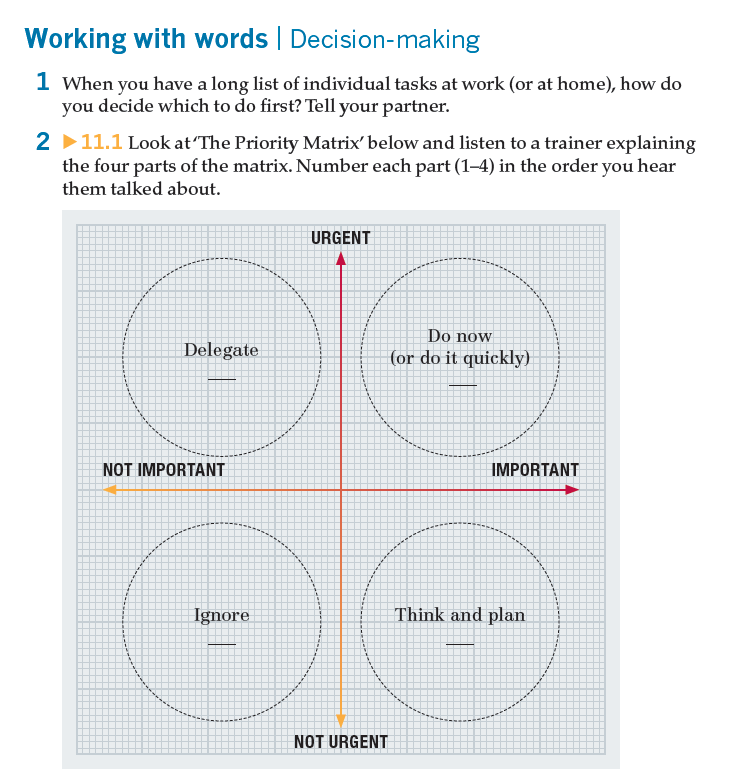 What’s the point of talking about this?
What’s the point of talking about this?
Because exploring a topic with your class that they are interested in and passionate about can spark some great conversations. Discussing content that students don’t want to engage with is, in contrast, nowhere near as valuable.
In this post, Business English author John Hughes looks at the types of topics and texts which will get students speaking.
In Business English, most of our students want plenty of speaking practice and the opportunity to talk. However as teachers, we are all too familiar with the real challenge of finding a topic that students will be interested in speaking about – it’s never as easy as it sounds! This is a challenge for all teachers, but in Business English you also have to find topics that have relevance to students from all sorts of different business backgrounds.
One typical approach to any speaking lesson is to start by giving students a reading or listening text, or a short video to watch. Then set some comprehension questions to check their understanding and ask students to talk about the topic. If you’re lucky, you’ll have chosen a topic that your students have views on ?. If not, you’ll experience that sinking feeling when no one has much to say ?.
When approaching this kind of Business English lesson, here are four criteria I tend to consider about texts and topics which will get students speaking.
- Click-through topics
The world of online marketing refers to something called ‘click-through’. That’s when a link or advert attracts people and generates plenty of clicks through to a product page. In the same way, the topic you choose for students to discuss must be the sort of topic that would get lots of clicks if it was a link on a webpage. Ask yourself if you would click on it? Show it to a colleague and ask if they would. Do you think students would read it in their first language? If not, then why would they in English?
- Tell me more
Any type of text you choose to prompt discussion (and I include video here) works best when it’s real, authentic, and information-rich. For example, choosing a text about a fictional made-up company is rarely as interesting as a text about a real business. Also bear in mind that nowadays your students can conduct their own research about the topic online, they’ll soon know whether a topic is fictional!
- Tell me something new
Find topics that give your students something new. With pre-work students this might be easier than with experienced business students but fortunately the business world is full of new concepts that look at working in a new way. If you don’t believe me, try googling the terms shadow work, fun theory and upside-down management. These are all intriguing business concepts that have relevance to the life of any business student.
- Talking about something I can use
Finally, I like using texts where the students learn about a business skill and then apply their own experience. Take the below example from Business Result Second Edition. The students listen to a business trainer describing how to use a priority matrix to help in their own daily decision-making. The main idea is that you list all the decisions you have to make in the next few weeks and categorise them in four ways, as a result you can prioritise your decision-making (Note that this matrix works also well for busy teachers!).

[From Business Result Second Edition Intermediate page 72].
In the lesson, students begin by discussing how they approach decision-making, then they listen to the talk and understand how the matrix works. Next, students list five things that they must make a decision about this week and use the matrix. Then they tell their partner about their priorities AND describe why they put them into certain squares. Finally, they discuss the effectiveness of the process. In this case, the speaking task has meaning and students learn to do something new – not only in English but also in their job.
John Hughes is a teacher, trainer and ELT author. His titles for Oxford University Press include Business Result, Business Focus, Successful Meetings and Successful Presentations. John has also run Business English Teacher training courses for schools and teachers all around the world. At last year’s BESIG conference, he received The David Riley Award for Innovation in Business English and ESP.
*The diagram in this blog post is taken from page 72 of Business Result Second Edition Intermediate: ‘The Priority Matrix’ from Teach Yourself: Run Your Own Business by Kevin Duncan Copyright © Kevin Duncan, 2010. Reproduced by permission of John Murray Press, an imprint of Hodder and Stoughton Limited.


It is a very interesting article and the tips included are useful not only for Business English but also for other disciplines too.
Thanks Cristina. Yes, I think the rules for ‘engagement’ cut across disciplines
Thanks John! I totally agree with you. The matrix about decision making is a pergect subject whether for a manager, engineer or secretary. I love Business Results because they use authentic case studies. Lately i”ve been finding up-to-date articles in a Twitter feed by Inc. Magazine. It’s always fun to discover new thimgs with my students.
Hi Ellen. Yes, INC has interesting topics – I also like the magazine and website Fast Company – full of news and ideas.